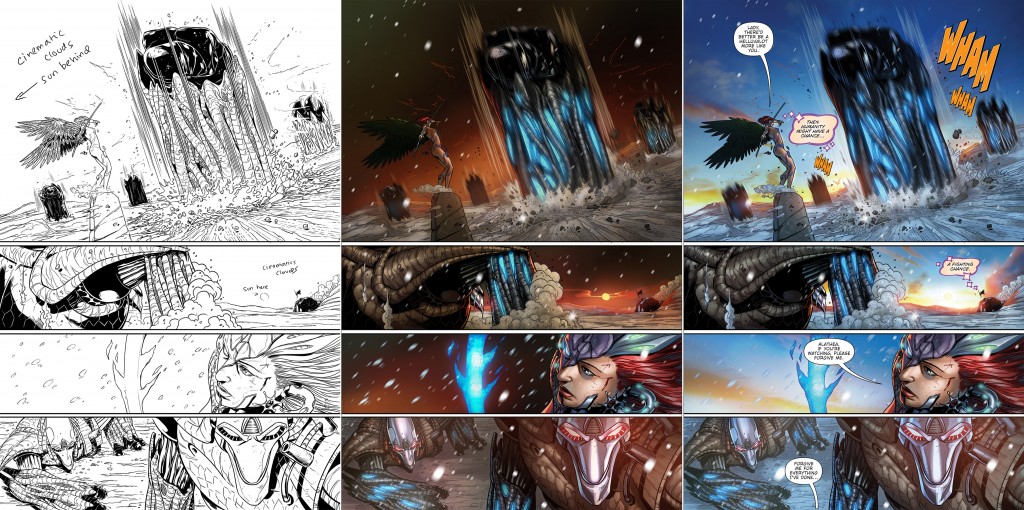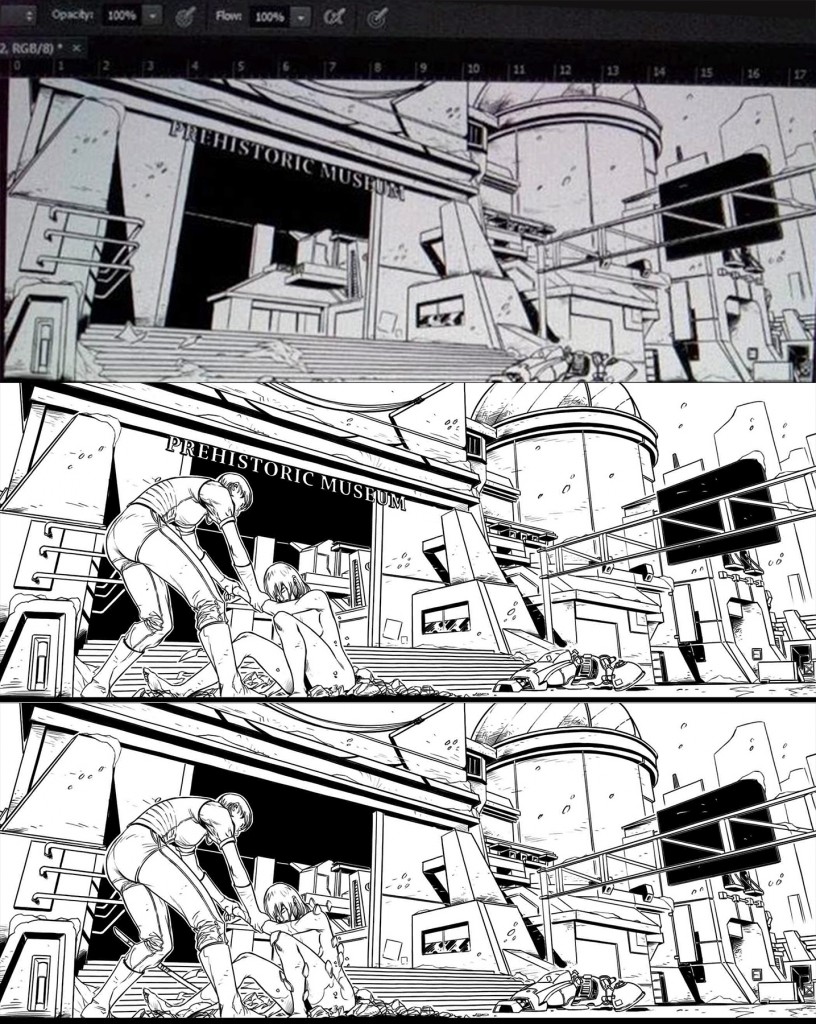We’ve been talking at length about panel descriptions. Hopefully you’ve got a friend friend willing to collaborate, or found a forum somewhere that encourages people to post panel descriptions so that other people can try to draw them. Practice makes perfect! Aside from that, here are a few more tips that will save you time and money in the long run. I’ve already stressed the importance of establishing expectations with your art team well before sending them a script. In this section I’ll be discussing word balloons in panels, letterer notes, and the benefits to the revision process made possible by email.
Word Balloons
Let’s talk about word balloons for a second. Most panels are going to have them. While your line artist probably won’t handle placement of word balloons and letters, they will have to be aware of the fact that there will be word balloons in the panel. Ask your artist to consider a few things. First, the initial speaker should generally be to the left of the panel. Unless you have a specific reason to do otherwise, this is a good rule to follow. We read from left to right, so the first speaker should be to the left. If your artist is new to comics, make sure you are both on the same page to avoid unnecessary revisions. Second, ask your artist to sketch rough word balloons in the panel layouts in order to get a feel for the amount of space the text requires. If your artist isn’t doing page layouts ahead of time, they can sketch placeholder word bubbles on a blank layer over the art. This will make sure that your artist has accounted for the space the text will occupy in the panel (check this out to see what I mean).
Coloring and Lettering
Your script needs to be an instruction manual for the entire creative team, not just the line artist. Your colorist and letterer are going to have to work off of it, so it needs to guide them as well. If you have a specific color scheme in mind, or if a specific color is important to the story, that needs to be communicated to the colorist. Don’t expect them to guess. If the panel takes place at dawn, the colorist will only know to reflect that in the color of the sky if you tell them. Keep in mind your colorist might not read the script—they may just be working off the line art as it gets sent to them. [If that’s the case, communicate! Send an email or reach out to them through social media—Ed.] If a car needs to be red because someone will mention a red car several issues later, make a note specifically for the colorist.
Likewise, you have influence over how the lettering looks and on dialogue balloon placement. Maybe you have an idea about how to show a sound coming from off-panel, or want a specific way to bridge balloons between panels. Read any issue of Matt Fraction’s Hawkeye [also with standout artists like David Aja, Francesco Francavilla, and Annie Wu—Ed.] to get schooled on the many creative ways one can display voices on paper. I recommend including separate notes for the colorist and letterer beneath the main panel description so that you can easily find those notes again later and pass them on. It might work out best to email the colorist and letterer their notes separately, or for the line artist to include the notes on a blank layer in the art file.
Revisions
Thanks to technology—email, Facebook, Twitter, SMS, Instagram, and more—you can transmit your artistic vision 24/7 from almost anywhere on the globe. My artist and I discuss big ideas via email and send almost daily feedback via Facebook messenger. He sends me draft images and I can provide almost-live critique. In reality, your artist could draw live over Skype as he creates each panel while you give feedback in real time. But that would be awful. So write great panel descriptions! Some days my artist and I have a long discussion about pages or panels, and other days he just hammers out pages that I love. As a writer who does creator-owned work, I’m lucky to have such daily collaboration. Sometimes its the editor who works with the artist. Either way, technology allows you to go back and forth and make edits easily.
Expect that some of the panels won’t come out looking the way that you, as the writer, had envisioned them. It might be a lack of clarity in the script, or perhaps the artist interpreted things a different way. It could be a combination of both things, or maybe you’re just not happy with the art, tone, mood, or an expression on someone’s face. If your artist is working digitally, they can mask-out most errors and make a correction. In the contract have with my artist, one draft and up to three revisions are included in the page rate. It’s important to have such conditions in writing before you begin. Again, a good final product begins with the clear communication of expectations. Later, you can offer critique in an email or as an overlay where you point to the issues you’d like fixed. The artist I work with even draws backgrounds and foregrounds on separate layers to make revisions easier!
Reach an understanding with your artist. This will guide the panel description process. If the artist deviates from your script, how will you react? Do you see it as a plus or minus? What if they drop a visual element that will come into play many issues later? What if they add something cool that you didn’t think of? Build a good personal and professional relationship with your creative team early on. If you would like for them to offer suggestions and experiment with layout, let them know that. If there’s a specific goal that you, as the writer, feel strongly about then let the art team know that as well. Make sure all of the major stipulations regarding workload—like character design sketches and revisions—are included in a signed contract before work begins. Focus on the goal of making great panels and a stunning page—know that you and your artist will have to combine talents to make it all work. Use the technology you have at hand to advance new opportunities.
_________________________
Damian Wampler is a photographer, playwright, and international cultural liaison. His current graphic novel, Sevara, will be published in April 2015 by Broken Icon Comics. Check out his website at www.damianwampler.com
makingcomics.com


The relationship and connection with the rest of the team is fundamental to apply concepts…like color…viewpoints about the compositions….etc…for that to write notes in the roughs are very helpful…thanks…